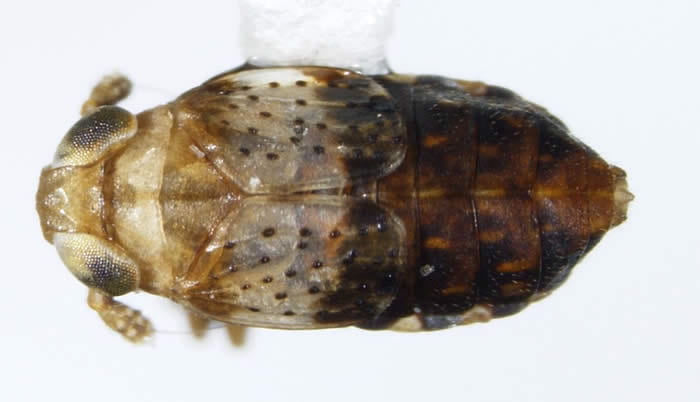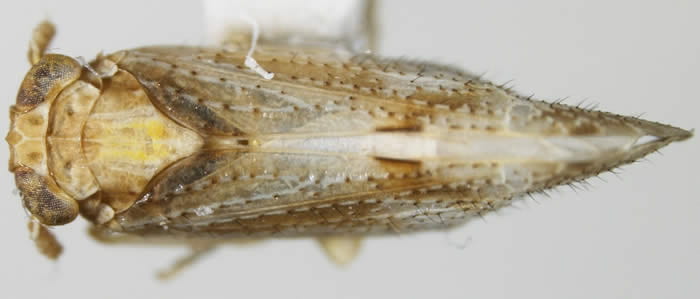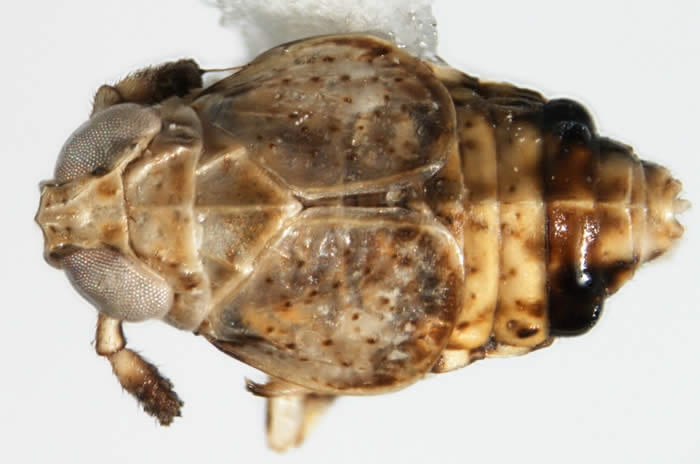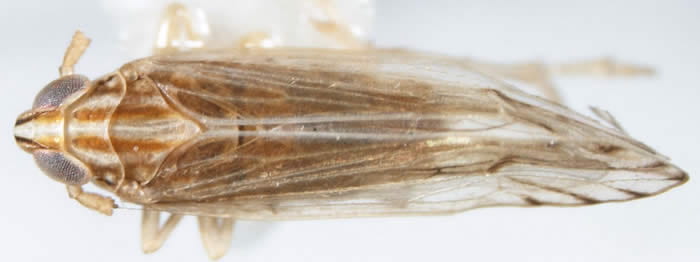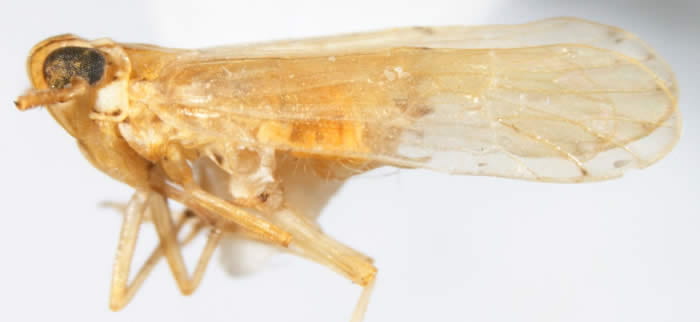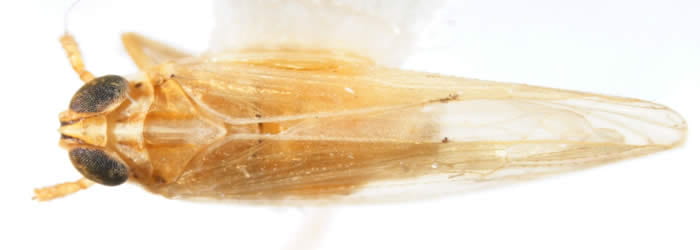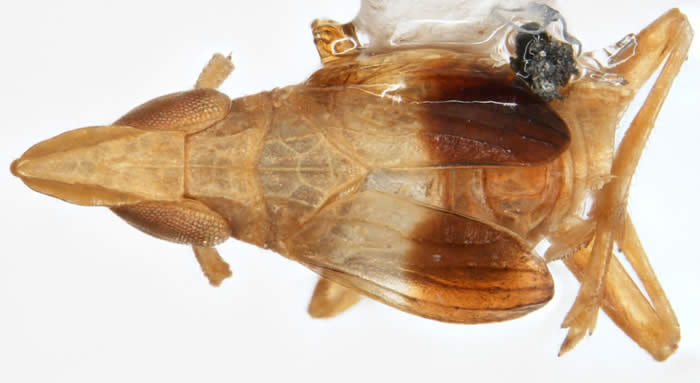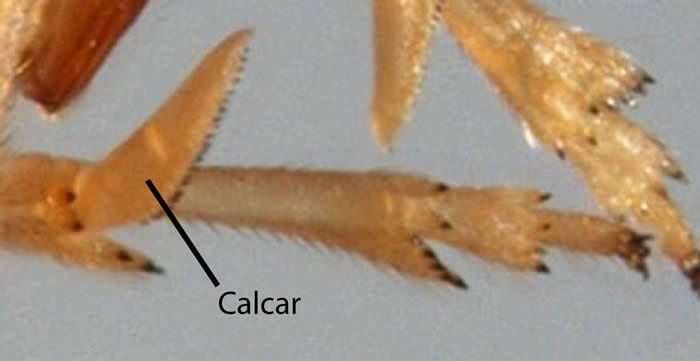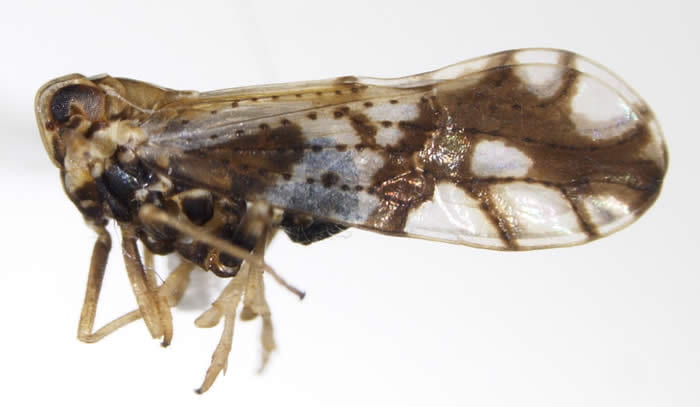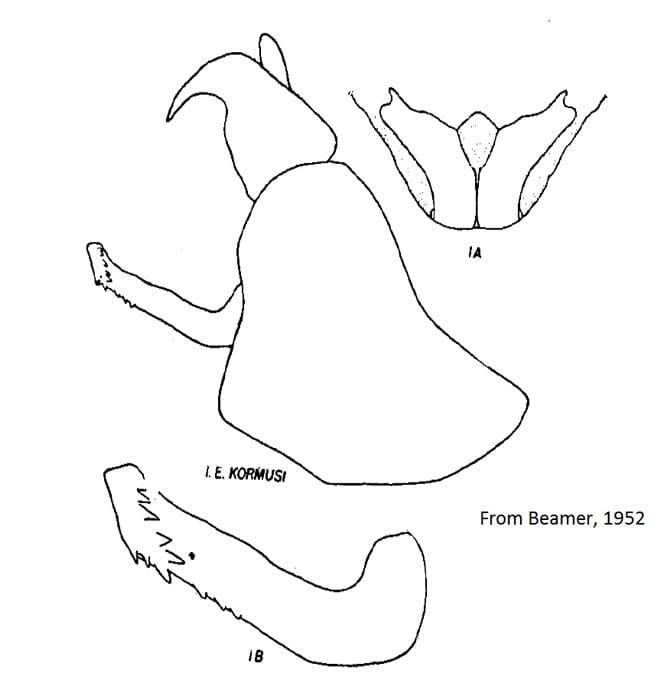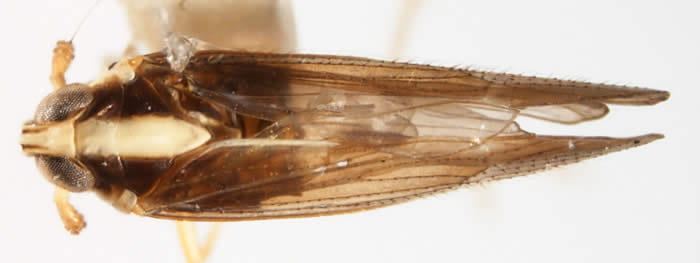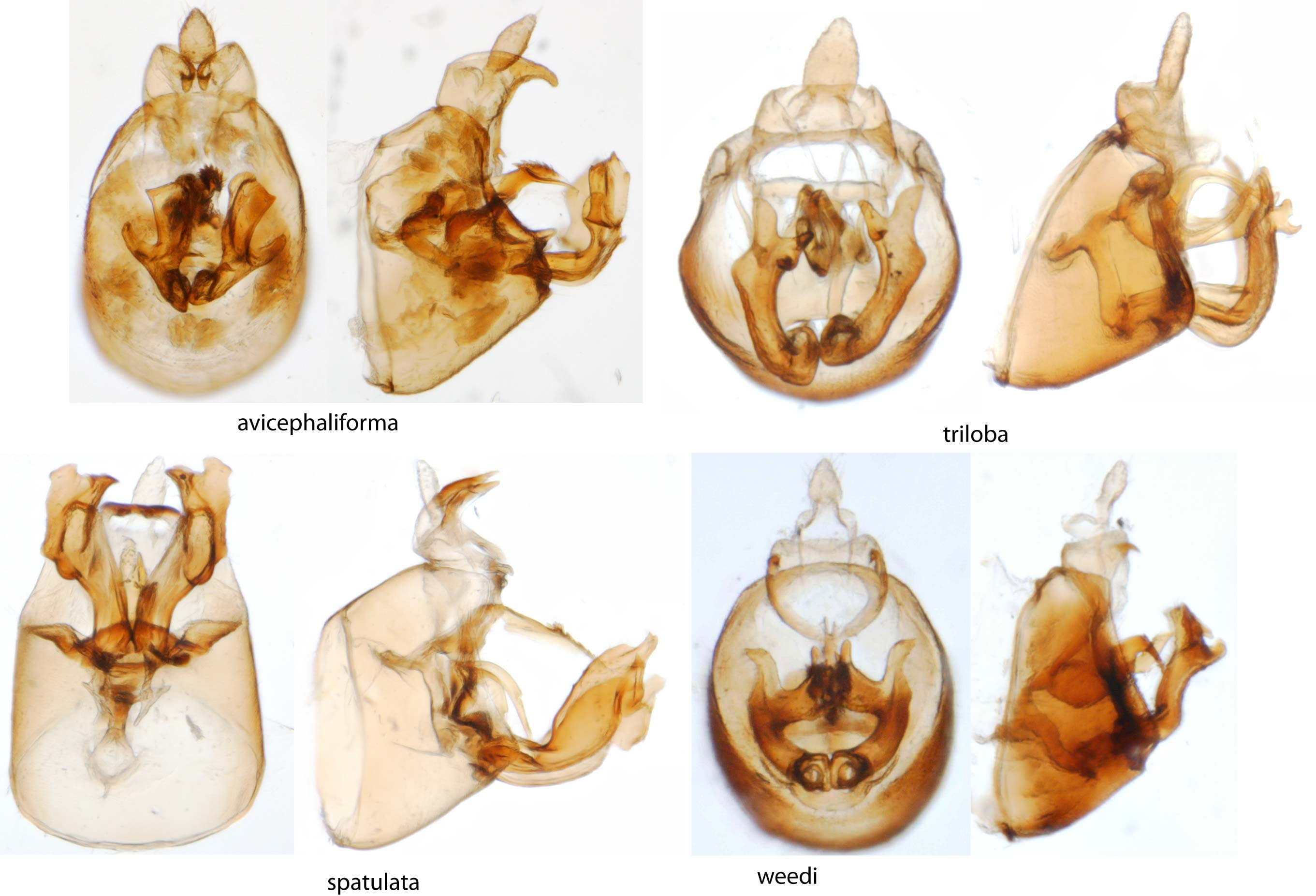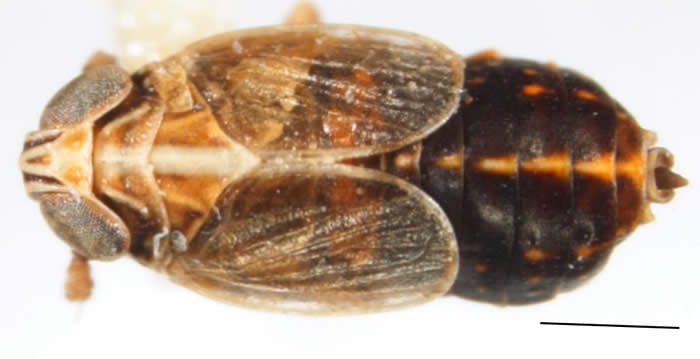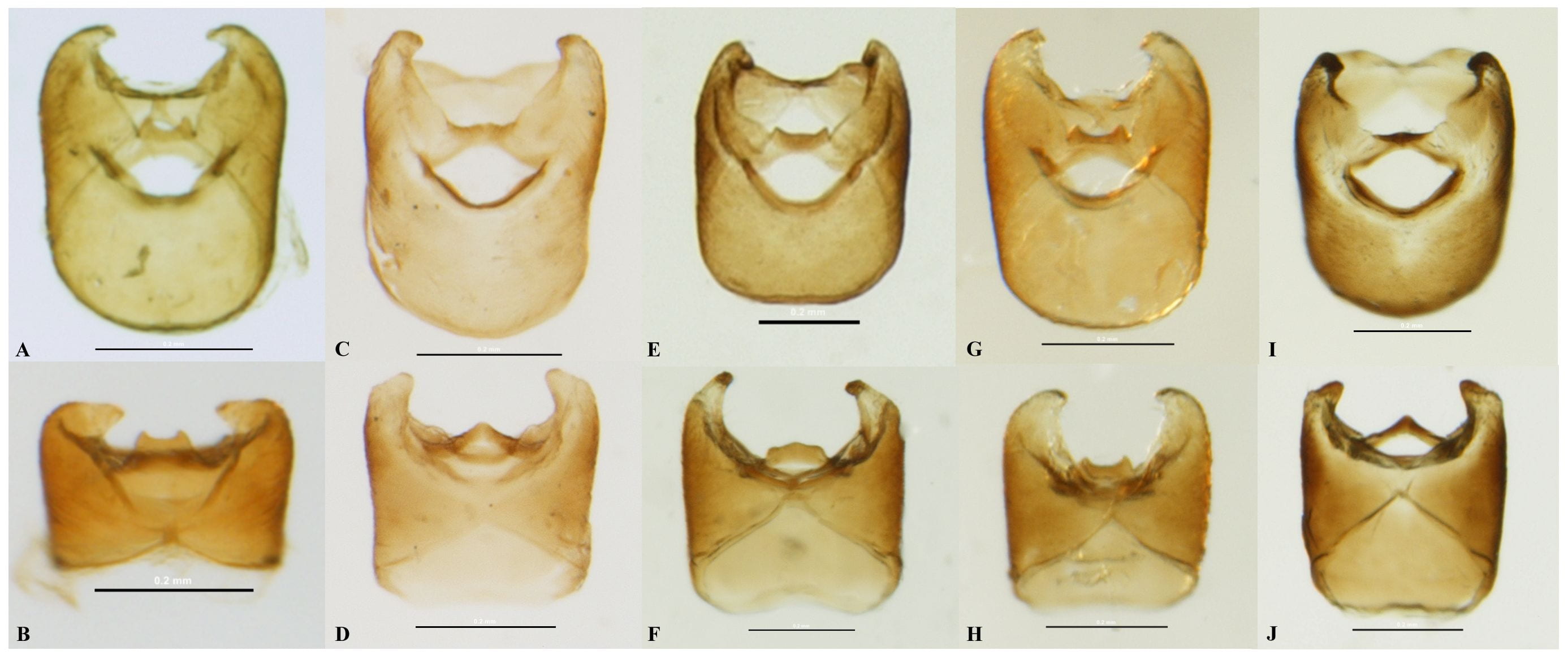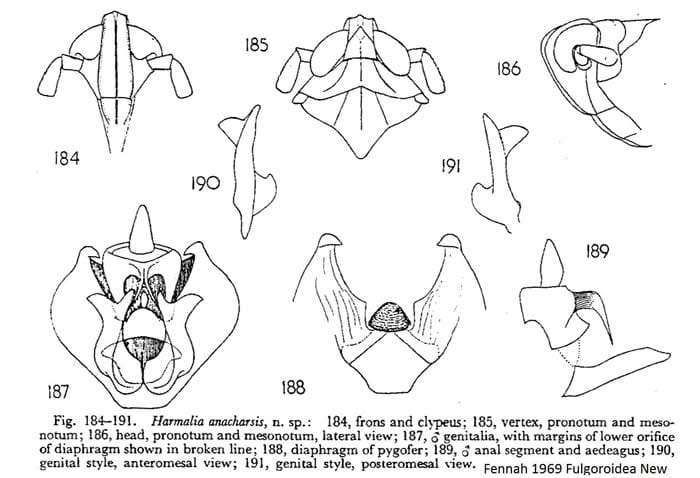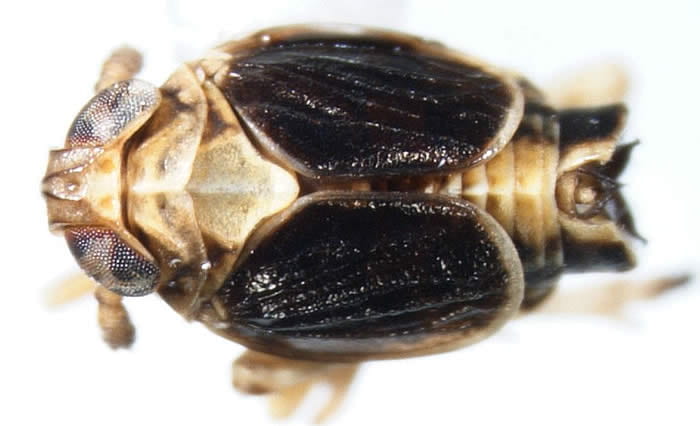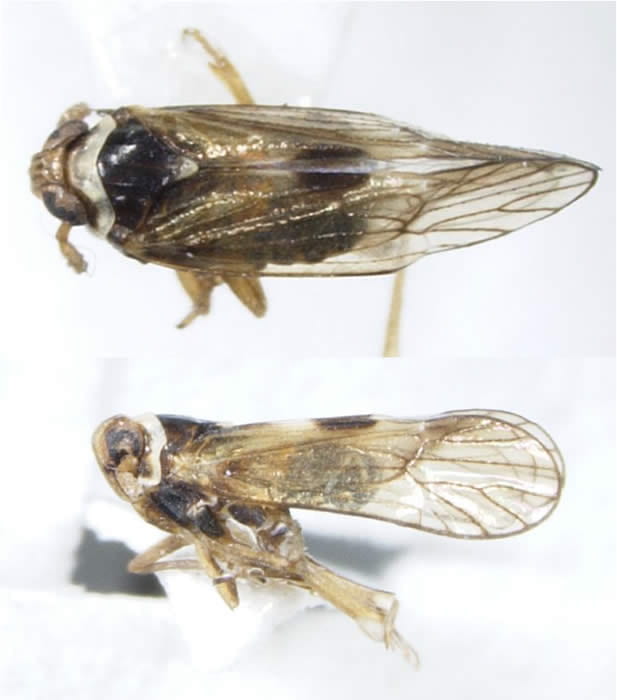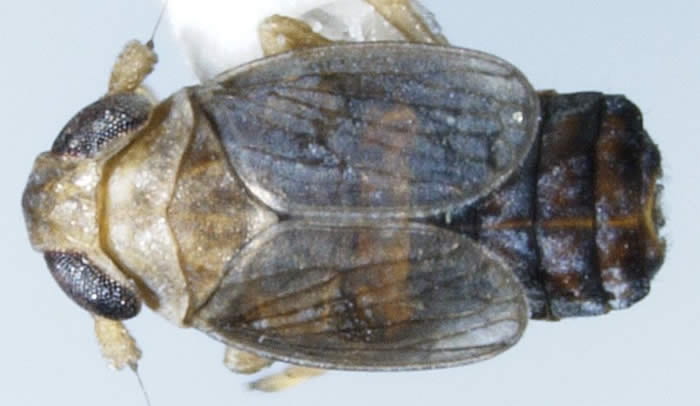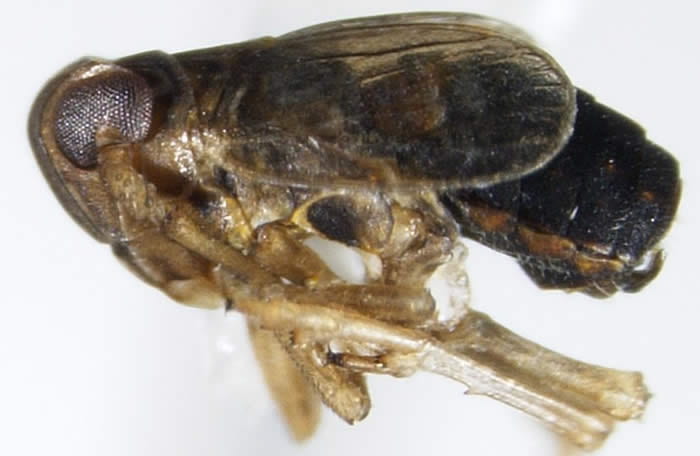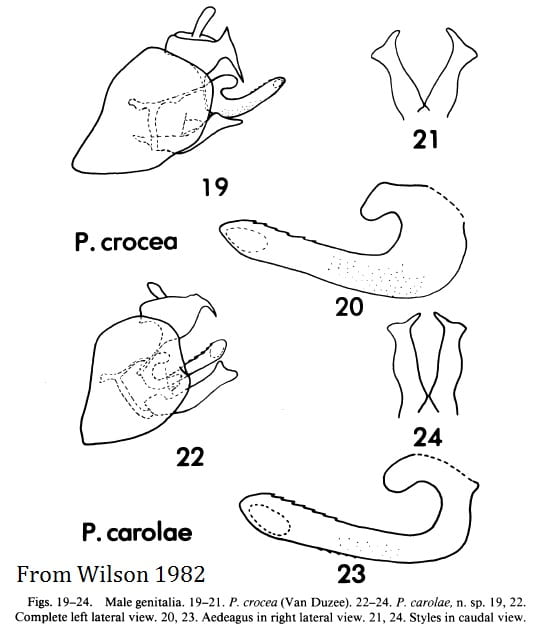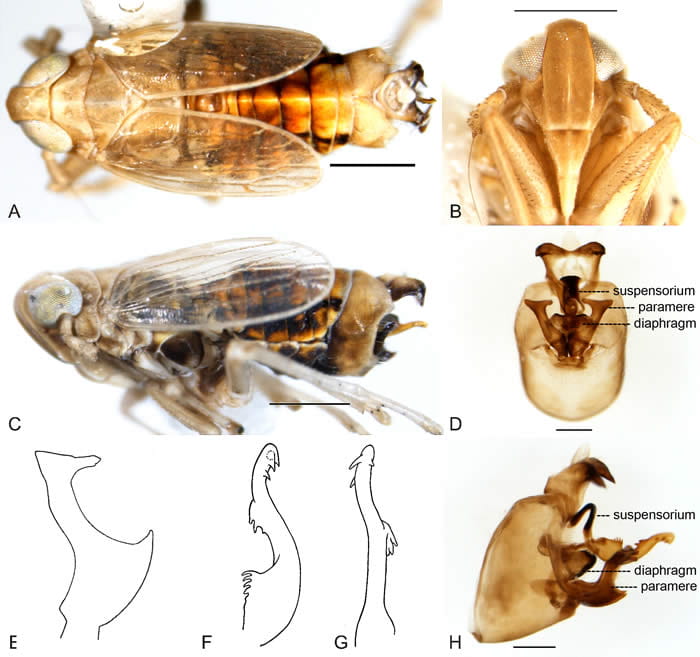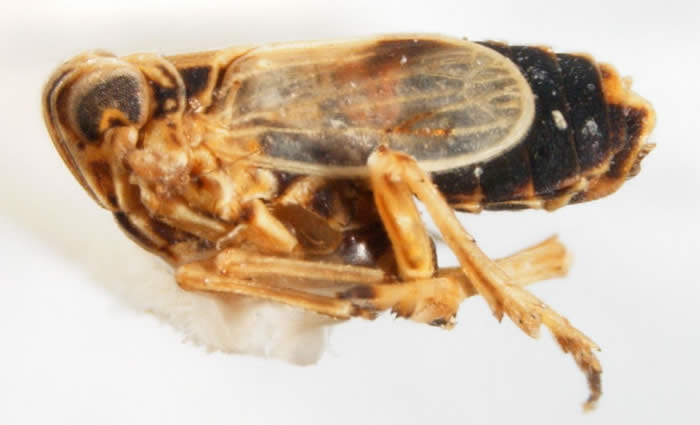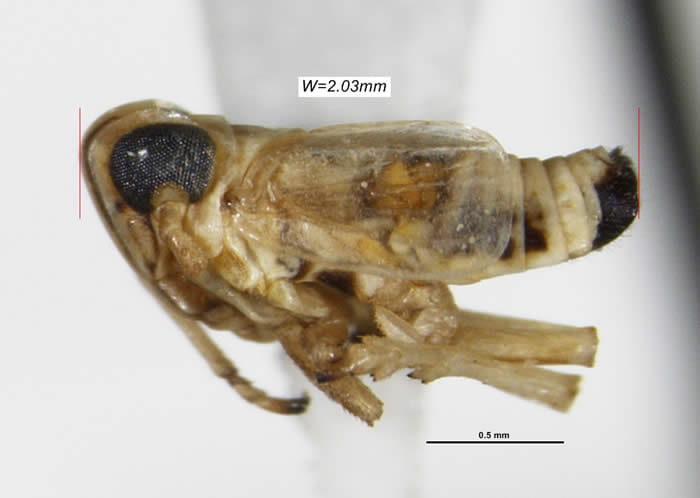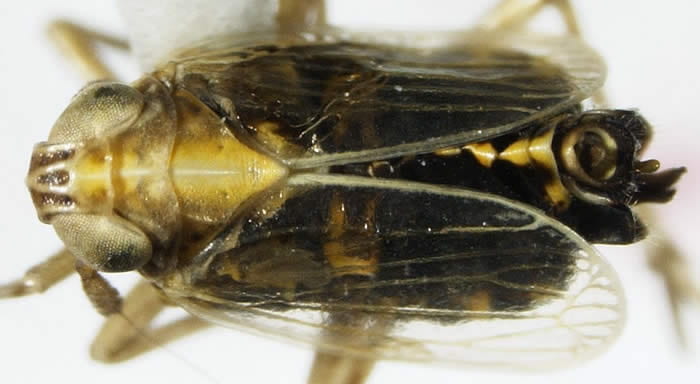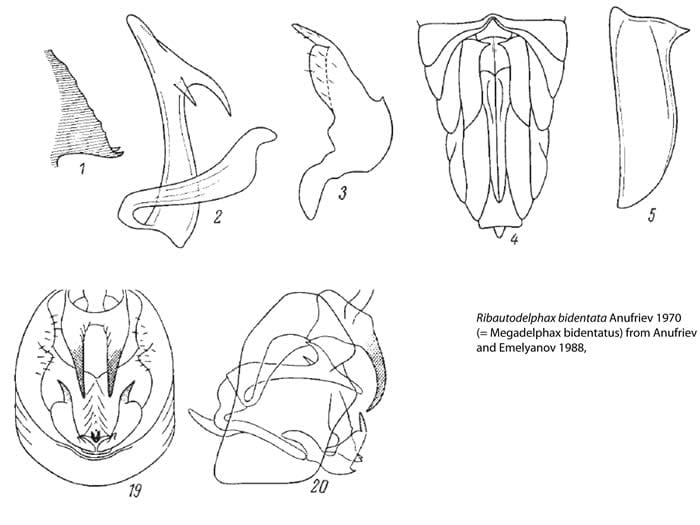[Back to Higher classification of Delphacidae]
[Back to A checklist of New World delphacid species]
Identification of the genera of Delphacidae north of Mexico (males only).
[draft as of 20 Dec 2017; still reviewing but substantively complete; there may remain some images wanting of figure references needing to be fixed]
This key is adapted and modified from Bartlett et al. 2014. Figure references were removed from the text in exchange for illustrations inserted among the couplets. The taxonomy has also been updated. It should be understood that comments are intended to be in reference to North American taxa only.
Figure 0. Terminology of male delphacid terminalia. Segment 10 may be referred to as the ‘anal tube’; the parameres have been in the past referred to as ‘styles’ or ‘genital styles’ (as opposed to the processes on segment 10 that were one referred to as ‘anal styles’, which is why I prefer to avoid that terminology. The parameres may also be referred to as ‘gonostyli’. The term ‘parameres’ represents an implied homology with the outer paraphallic lobes of (e.g.) Snodgrass (1935), which some writers reject or simply wish to avoid. The suspensorium is an extension of the phallobase (between the aedeagus and the base of segment 10), which is only clearly evident in the Delphacini, but some authors might consider a suspensorium present in some other derived Delphacidae. In Delphacinae the phallotheca and aedeagus are entirely fused, and the composite structure should probably more precisely be called a ‘theca’, but most descriptive taxonomy authors nonetheless call it the aedeagus.
Note: This key is designed for males only because male genitalic features are usually needed to recognize the higher taxa and many genera. Delphacids are frequently sexually dimorphic, with color or structural details varying between genders making it sometimes hard to associate males and females. Delphacodes is polyphyletic and will key out in several places, but all Delphacodes species (particularly rare taxa) may not have been accounted for in the current key. Other genera may not be uniform in some features.
1- Post tibial spur (calcar) spine-like; circular or quadrate in cross-section (Fig 1A below), not bearing teeth on the posterior margin; aedeagus bearing a well-developed apical flagellum (Figs. 2a,b); larger species, over 4 mm … (Asiracinae) 2
1.’ Post tibial spur flattened, usually tectiform or foliaceous and usually bearing black-tipped teeth on posterior margin (Figs. 1B-D); aedeagus with flagellum lacking or vestigial … 3
Figure 1. Calcar of Delphacidae. A. Asiracinae; B. Kelisiinae; C. Stenocraninae; D. Delphacinae: Tropidocephalini.
Figure 2a. Terminalia of Ugyops sp. showing terminal retrose flagellum on aedeagus.
Figure 2b. Aedeagus of Pentagramma cosquina showing terminal retrose flagellum.
2- Antennae long and strongly flattened (Fig. 3); color earth-toned … Copicerus irroratus Swartz
2.’ Antennae short, terete (Fig. 25B); green (Fig. 25F) … Pentagramma Van Duzee
Figure 3. Front of Copicerus irroratus showing elongate, flattened antennae.
Figure 4. Front of Pentagramma showing short, terete antennae.
3- Aedeagus with sperm-conducting tube strongly sclerotized and clearly evident, vestigial aedeagal flagellum may be present; aedeagus either with well developed phallotheca incompletely surrounding the aedeagus (Fig. 5, right) aedeagus movable within phallobase, which usually bears a ventrally directed apical process); OR having 1-2 elongate subanal processes (Fig. 5 left) derived from link between base of aedeagus and anal segment (abdominal segment 10, dorsad of genital opening in caudal view) … (Stenocraninae and Kelisiinae) 4
3.’ Aedeagus with sperm conducting tube not conspicuous (aedeagus fused with phallobase to form theca) (Figure 6); aedeagal flagellum absent; processes never present from link between aedeagus and anal segment … (Delphacinae) 7
Figure 5. Terminalia of Kelisia flava (left) and Obrusicranus bifidus.
Figure 6. Lateral view of terminalia of Flavoclypeus andromedus; aedeagus and phallobase fused forming a theca; ‘sperm conducting tube’ not sclerotized.
4- Calcar solid, slightly concave on inner surface, with large distinct conical teeth on posterior margin (Fig. 1b); male genitalia having 1-2 elongate subanal processes (Fig. 5, left) derived from link between base of aedeagus and anal segment; anal segment without paired processes; gonoplacs of female never greatly enlarged … (Kelisiinae) Kelisia Fieber
4.’ Calcar foliate, tectiform, with numerous small teeth on the posterior margin (Fig. 1c); aedeagus with well developed phallotheca incompletely surrounding the aedeagus, usually bearing a ventrally directed apical process (Fig. 5, right; processes absent on link between aedeagus and anal segment; anal segment with paired processes; gonoplacs of female usually greatly enlarged (Fig. 7A), frequently wax-bearing … (Stenocraninae) 5
Figure 7. Ovipositor of Stenocraninae. A. Gonoplacs expanded (Frameus porrectus Bartlett), B. Gonoplacs normal (Kelisicranus arundiniphagus Bartlett).
5- Median carina of frons paired (Figs. 26B); anal segment with 2 paired processes (Fig. 49J) … Obtusicranus bicarinus Bartlett
5.’ Frons with single median carina (Fig. 26A, C, D); anal segment usually with 1 pair of processes (Fig. 49I; except Stenocranus arundineus) … 6
Figure 8. Front of Obtusicranus bicarinus (left) showing bicarinate median frontal carina, and Stenocranus similis.
6- Angle between vertex and frons acute in lateral view, vertex projected in front of eye for nearly width of eye (Fig. 9); gonoplacs of female not greatly expanded (similar to Fig. 7b) … Kelisicranus arundiniphagus Bartlett
6.’ Angle between vertex and frons rounded in lateral view (somewhat acute in S. acutus), vertex only slightly projected in front of eye (Fig. 9); gonoplacs of female greatly expanded (similar to Fig. 7A, except S. similis) … Stenocranus Fieber
Figure 9. Lateral view habitus of Stenocranines. top Kelisicranus arundiniphagus, below Stenocranus sandersoni.
7- Fragile forms, usually green or yellowish green (Fig. 10; ours with acutely pointed head in lateral view); distal spines of posterior tibiae with 2 inner and 5 outer spines; aedeagus elastic, strongly elongate, in repose curled within membranous bag comprised of diaphragm; 1 species in the U.S.; on sugarcane and Andropogon grasses … (Saccharosydnini) Saccharosydne saccharivora (Westwood)
7.’ Form various, usually stout, lacking the above features (most similar taxa – Neomegamelanus and Tumidagena – are not green; Fig. 11); distal spines of posterior tibiae with 2 inner and 3 outer spines; aedeagus not as above (most delphacids) … (Delphacini) 8
Figure 10. Saccharosydne saccharivora; dorsal habitus (top); terminalia and head, lateral view and legs (bottom).
Figure 11. Lateral habitus of Tumidagena (top) and Neomegamelanus.
8. Antennal segments (at least basal segment) flattened in cross-section (e.g., Fig. 12) … 9
8.’ Antennal segments terete (round) in cross section … 13
Figure 12. Front of Stobaera showing flattened antennae.
9- Frons very broad dorsally, rather peltate (Fig. 13); median carina of frons strongly forked ¾ distance between vertex and frontoclypeal suture … Bostaera Ball
9.’ Frons not peltate and not as broad dorsally (e.g., Fig. 14), median carina of frons not forked or forked less than ¼ distance between vertex and frons … 10
Figure 13. Front of Bostaera nasuta.
10- Larger species, ca. 4.5 mm; dark colored with broad pale dorsal median vitta on thorax, macropterous; frons strongly bicolored (Fig. 14; dorsally dark and pale ventrally); pygofer opening with 2 processes on ventral margin; southeastern US and Neotropics, adventive on sugarcane … Perkinsiella saccharicida Kirkaldy
10.’ Smaller species, less than 3.5 mm; without pale median vitta on thorax (if present frons not as above); frons varied; pygofer opening usually without processes … 11
Figure 14. Front of, terminalia and dorsal view of Perkinsiella saccharicida.
11- Frons brownish, without spotting, with dark band along frontoclypeal margin (Fig. 15); usually brachypterous with conspicuous setal bases; adventive on Juncus; known from southeastern Canada and Washington state … Conomelus anceps (Germar)
11.’ Frons varied, usually pale and maculated (Fig. 39C); widespread … 12
Figure 15. Front and dorsal habitus of Conomelus anceps.
12- Male pygofer without median processes on ventral margin of opening (Fig. 16); segment 10 with 1 process, originating from middle of ventrocaudal margin; usually macropterous with cream, yellow and orange themes; mostly Ambrosia feeders, widespread … Stobaera Stål
12.’ Male pygofer with median processes on ventral margin of opening (Fig. 17); segment 10 with 2 processes, originating from lateral portion of ventrocaudal margin; usually brachypters … (few; relevant species, quadripustulatus and tessellatus, southeastern) Pissonotus Van Duzee[1]
Figure 16. Caudal view of male terminalia of Stobaera tricarinata (left) and Stobaera pallida; and dorsal habitus of Stobaera pallida.
Figure 17. Dorsal habitus and frons of Pissonotus quadripustulatus and caudal view of male terminalia of Pissonotus albovenosus and Pissonotus piceus (terminalia of piceus with labels).
13- Frons and vertex with distinct pits (Fig. 18) … 14
13.’ Frons and vertex without distinct pits (may have spots) … 15
Figure 18, frontal view of Laccocera (left) and Achorotile.
14- Median carina of frons (of adults) singular (Fig. 18, left) … Laccocera Van Duzee
14.’ Median carina of frons (of adults) paired (Fig. 18, right) … Achorotile Fieber
15- Frons with 2 median carinae (Figs. 19-20), or with median carinae forked near frontoclypeal margin (length of stem less than length of paired carinae) … 16
15.’ Median carina of frons single, or forked closer to fastigium (e.g., Figs. 15, 17) … 19
Figure 19. frontal view of Rotundifronta (left) and Criomorphus.
Figure 20. Frontal view of Macrotomella (left) and Bakerella angulata.
16- Frons broad, uniformly colored, lateral margins strongly rounded, median carinae weak (Fig. 19); head in lateral view obtusely rounded from vertex and declinate; very small species (less than 2.6 mm); body uniformly light brown (Fig. 21); Florida only (rare) … Rotundifronta lutea Beamer
16.’ Frons not as above (e.g., Fig. 20) and usually larger species; if small then frons spotted (similar to Fig. 20, right); frons with parallel sides or weakly convex, head not obtusely rounded in lateral view, median carinae strong or weak; body not uniformly colored … 17
Figure 21. Dorsal habitus of Rotundifronta.
17- Frons spotted (Fig. 20, right), median carinae joined to single stem near frontoclypeal suture, very small species (less than 2.0 mm); antennae very short … (few) Bakerella Crawford (e.g., pediforma)
17.’ Frons not spotted (Figs. 19 right, 20 left), median carinae not joined to single stem; larger species (more than 2.5 mm); antennae longer … 18
18. Frons uniformly colored (Fig. 19 right); carinae inconspicuous on frons and thoracic nota (Fig. 22, top); frons of head rounded in lateral view; male parameres strongly diverging; brachypterous forewing apically pale contrasting with reddish-castaneous forewing and abdomen; uncommon northern species … Criomorphus Curtis
18.’ Frons pale, darkened along carinae (Fig. 20 left); carinae conspicuous on frons and thoracic nota (Fig. 22 bottom); head in lateral view somewhat angled apically; male parameres parallel; southeast and Neotropics … Macrotomella carinata Van Duzee
Figure 22. Dorsal habitus of Criomorphus (top) and Macrotomella.
19- Male pygofer with elongate processes or distinct median projection on (or near) ventral opening (in front of parameres in caudal view) (similar to Fig. 23-25) … 20
19.’ Male pygofer without median processes or pronounced median tooth on ventral margin (lateral projections may be present) … 28
Figure 23. Terminalia of Phrictopyga contorta (left, semi-caudal view) and Pygospina spinata (right, lateral view)
Figure 24. Terminalia of Pissonotus binotatus and Megamelus paleatus (note processes of pygoferin front of – in this view – parameres)
Figure 25. Pygofer of Parkana alata (left, anal tube, parameres, aedeagal complex removed) and terminalia of Scolopygos pallida.
20- Slightly flattened, pale delphacids, with a median thoracic vitta (Figs. 37H, 38H); segment 10 of male genitalia with single median process (Figs. 60C, 61C); pygofer with lateral processes in addition to a pronounced median projection on the ventral margin (which may be forked) (southern species) … 21
20.’ Not as above … 22
21- Pygofer process apically forked (Fig. 60C), originating directly on midventral rim; in lateral view, pygofer (in our species) broadly dentate (Fig. 60H), posterior most extension about at midlength, lacking posterior directed processes … Phrictopyga Caldwell
21.’ Pygofer processes not forked (Fig. 61C), originating somewhat ventrad of rim; pygofer more rounded in lateral view (Fig. 61H), bearing (in our species) a pair of elongate posteriorly directed processes … Pygospina Caldwell
Figure 26. Phrictopyga occidentalis
Figure 27. Pygospina contorta
22- Male genitalia in caudal view expanded (Fig. 24, left), with inflated or folded appearance; processes of pygofer stout (mostly dark colored with pale markings, larger delphacids with slightly projecting heads and a large, thin foliaceous calcar; associated with wetlands) … Megamelus Fieber
22.’ Male genitalia without inflated appearance; processes of pygofer slender … 23
23- Pygofer with paired processes on ventral margin (Figs. 24 right, 25), which may be closely approximated … 24
23.’ Pygofer with (small) single median process or tooth on ventral margin (e.g., Fig. 28) … 26
Figure 28. Pygofer of Akemetopon inornatum showing single median process at opening.
24- Processes of ventral margin of opening of male pygofer strongly asymmetrical, left process curved and twice length of right (Fig. 25 left); pygofer in lateral expanded on dorsolateral margins of pygofer opening; western … Parkana alata Beamer
24.’ Processes of ventral margin of opening of male pygofer symmetrical (Fig. 24 left), or weekly asymmetrical (Fig. 25 right); pygofer in lateral view not excavated … 25
25- Processes of ventral margin of opening of male pygofer separated at base (Fig. 24 left); most taxa reddish-brown to dark-chestnut brown, often brachypterous (Figs. 30a); clypeus deep chestnut brown (Fig. 30b), usually with a contrasting pale band along frontoclypeal suture of frons; widespread … (most) Pissonotus Van Duzee
25.’ Processes of ventral margin of opening of male pygofer closely approximated, slightly asymmetrical; body uniformly brownish orange (Fig. 31); Alberta … Scolopygos pallida Bartlett
Figure 29. Pygofer of Neomegamelanus bicolor showing single median process at opening.
Figure 30a, Pissonotus species, dorsal view: Pissonotus basalis (top left). P. albovenosus (top right), P. piceus (bottom left), P. delicatus (bottom right)
Figure 30b, Pissonotus species, front: Pissonotus delicatus (top left). P. albovenosus (top right), P. piceus (bottom left), P. marginatus(bottom right)
Figure 31. Scolopygos pallida.
26- Head and thorax straw-colored (including forewing; females entirely stramineous), abdomen dark; body somewhat flattened; frons acutely pointed dorsally (Fig. 32) … Megamelanus bicolor Ball
26.’ Color not as above; frons not acutely pointed dorsally … 27
Figure 32. Neomegamelanus bicolor
27- Color shiny castaneous to deep reddish brown (Fig. 33); frons wide, lateral margins convex, usually with median carina reduced; head slightly flattened and projecting in lateral view, fastigium carinate (A. inornatum) or not (A. ainigma); aedeagus with lateral rows of teeth, parameres forceps-like (Fig. 28) … Akemetopon Weglarz & Bartlett
27.’ Color dull brown, abdomen contrastingly dark (Fig. 34); frons parallel sided, median carina distinct; body not flattened, fastigium rounded in lateral view; aedeagus with pair of large apical dorsal processes … Kosswigianella (Acanthodelphax LeQuesne)
Figure 33. Akemetopon inornatum
Figure 34. Kosswigianella (Acanthodelphax) analis.
28- Fore and middle tibiae distinctly expanded; robust, chestnut colored species with white spots on frons (Figs. 35); northern … Phyllodinus nervatus Van Duzee
28.’ Fore and middle tibiae not expanded … 29
Figure 35. Phyllodinus nervatus
29- Frons spotted and distinctly rounded on lateral margins (Fig. 20 right, Fig. 36); clypeus at distinct angle relative to frons in lateral view (Fig. 36 lateral view); small species (usually less than 2.5 mm), antennae very short; wings with conspicuous setal bases, usually brachypterous, calcar short with teeth vestigial … (most) Bakerella Crawford
29.’ Not as above … 30
Figure 36. Bakerella cinerea.
30- Body somewhat (Fig. 37) to decidedly (Fig. 30) compressed, usually with head projected in front of eye or head angulate in lateral view; some forms decidedly slender (Fig. 38); most forms from coastal marshes … 31
30.’ Body not compressed, head in lateral view with fastigium rounded (Fig. 23B), head not projected in front of eye; form not slender … 35
Figure 37. Prokelisia marginata and frontal view of Prokelisia crocea.
31- Vertex conspicuously projected in front of eyes (Figs. 38, 39); in dorsal view, acute to obtusely pointed (Fig. 38, less obvious in T. minuta); in lateral view head projected in front of eyes for half width of eyes or more; often with a carina from compound eyes to frons (Fig. 39); head often acutely pointed in lateral view; narrow-bodied, fragile forms … 32
31.’ Vertex not conspicuously projected in front of eyes; head in lateral view seldom projected more than ¼ width of eyes; carina from compound eyes to vertex always absent; form various but usually more robust … 33
Figure 38. Tumidagena minuta (top), T. terminalis (middle), T propinqua (bottom)
Figure 39. Neomegamelanus elongatus.
32- Head in lateral view with anteriorly directed carinae from compound eye toward apex of head (Fig. 39), head acutely pointed in dorsal view; pronotum flared at lower margin; brachypters and macropters with wings as long as abdomen … Neomegamelanus McDermott
32.’ Head without anteriorly directed carinae from compound eye; head swollen in appearance from dorsal view, vertex rather rounded laterally, widest just anterior to eyes; in two of three species, head is considerably forward projecting, about width of eyes; brachypters with wings half-length of abdomen with conspicuous dark area on apex of forewing males (Fig. 38) … Tumidagena McDermott
33- Wing of brachypters truncate, leaving several segments of abdomen visible from above (macropters unknown); body decidedly flattened (Fig. 40) and uniformly stramineous; east coast on blackrush … Keyflana hasta Beamer
33.’ Wings of brachypters and macropters reaching or exceeding tip of abdomen (e.g., Fig. 37, top); body slightly compressed … 34
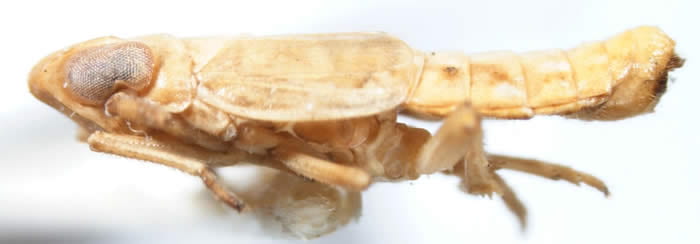
Figure 40. Habitus of Keyflana hasta.
34- In dorsal view, body with median pale vitta accented by lateral dark markings on thorax, abdomen, and middle of forewing (Fig. 41); head slightly pointed in lateral and dorsal views; frons subparallel; southern Florida, rarely encountered … Kelisoidea versa Beamer
34.’ In dorsal view, body without lateral dark markings and usually without pale median vitta (Fig. 37); head more rounded; frons widest near frontoclypeal suture or subparallel, usually margined with fuscous markings; abundant on Spartina … Prokelisia Osborn
Figure 41. Kelisoidea versa.
35- Calcar lacking black-tipped teeth on posterior margin, often short and thickened; stout forms (e.g., Fig. 45) (except Liburniella, Fig. 43) (if calcar large and foliaceous go to 39 even if teeth apparently absent – some Nothodelphax) … 36
35.’ Calcar with black-tipped teeth on posterior margin, usually foliaceous (Figs. 42) … 39
Figure 42. The calcar of Syndelphax alexanderi.
36- Wings distinctly patterned (Fig. 43; in both macropters and brachypters), with distinct dark setal bases; usually macropterous, brachypters with wings reaching apex of abdomen; body not particularly robust, with conspicuous median dorsal vitta; carinae of frons conspicuous; areolet of vertex rounded (arms of Y-shaped suture absent); abundant and widespread, especially east … Liburniella ornata (Stål)
36.’ Wings not particularly patterned, setal bases not conspicuous; usually brachypters, wings leaving several abdominal tergites exposed from above (Figs. 44-46); body stout, color varied; carinae of frons reduced or inconspicuous; arms of Y-shaped suture present; relatively uncommon, mostly western … 37
Figure 43. Liburniella ornata
37- Frons bicolored, dark brown ventrally (Fig. 44), pale dorsally; brachypter rather uniform colored, with abdomen stramineous medially, dark laterally; known from holotype female only; California … Kormus californicus Crawford
37.’ Frons not distinctly bicolored; body either uniformly pale or rather distinctly patterned (Figs. 45, 46) … 38
Figure 44. Kormus californicus.
38- Male paramere with finger-like projection on inner margin; aedeagus upturned (Fig. 45) … Eurysa kormusi (Crawford)
38.’ Male paramere without finger-like projection on inner margin; aedeagus downturned (Fig. 46) … Eurybregma Scott
Figure 45. Eurysa kormusi (line art of terminalia from Beamer 1952).

Figure 46. Eurybregma magnifrons (line art of terminalia from Beamer 1952).
39- Male parameres distinctly branched, either Y-shaped with distinct inner and outer branches, or multiply branched (e.g., Fig., 47); most often macropterous, and most taxa relatively large and uniformly colored (except Sogatella) … 40
39.’ Male parameres not branched, may be toothed or apically bilobed, or have extended basal angle; form variable (if dark with frons strongly contrasting with clypeus – e.g., Fig. 29A – go to 43) … 43
Figure 47. Examples of “branched” parameres.
40- Thorax with distinct pale median vitta (Fig. 38); median carina of frons forked below fastigium (arms narrowly diverging); parameres asymmetrically Y-shaped; medioventral portion of genital diaphragm forming broad U-shape (Fig. 62A); basitarsis of hind leg without teeth … Sogatella Fennah
40.’ Thorax without distinct pale median vitta (Figs. 35H, 36H); median carina of frons forked at fastigium; parameres multiply branched or Y-shaped; genital diaphragm not as above; some taxa with teeth on hind leg basitarsus (Figure 49) … 41
Figure 48. Tagosodes albolineosus (top) and Sogatella kolophon.
41- Basitarsus of hind leg with 1-4 teeth (Fig. 49); parameres usually Y-shaped (Fig. 49) … Nilaparvata Distant
41.’ Basitarsus of hind leg without teeth; parameres usually complexly branched (Fig. 59C) … 42
Figure 49. Nilaparvata basitarsus showing lateral teeth.
42- Armature of the genital diaphragm avicephaliform with pair of elongate, greatly projecting dorsocaudal processes; parameres complexly branched … Pareuidella Beamer
42.’ Armature of the diaphragm not as above; parameres asymmetrically Y-shaped or few-branched … Delphacodes indentistyla Dozier, D. lappae Beamer (possibly others such as D. dentis) [note: I think D. indentistyla is a Pareuidella, but Dozier’s types are missing and I can not verify features beyond the description]
Figure 50. Terminalia of Pareuidella
Figure 51. Terminalia of Pareuidella from Beamer 1951; note form of genital diaphragm.
Figure 52. Delphacodes lappae from Beamer 1947.
43- Segment 10 (anal segment) with strongly converging (cruciate) (Fig. 61D, E) or distinctly asymmetrical processes (pointed in different directions); parameres usually apically narrowed and distinctly curved laterally … 44
43.’ Segment 10 with processes symmetrical or absent … 45
Figure 53. Ribautodelphax pusilla terminalia, caudal view (note processes of anal tube) and anal tube (caudal view) of R. pungens from Den Bieman (1987). Megadelphax is very similar to Ribautodelphax, except (e.g.?) that the processes on the anal tube are not cruciate (crossed).
44- Segment 10 with processes asymmetrical, although not cruciate (Fig. 54); apex of paramere not hooked; wing with spot at apex of clavus … Delphacodes penepuella Beamer
44.’ Segment 10 with processes cruciate (Figs. 53); apex of paramere with inner angle narrowed and hooked laterally; wing without spot at apex on clavus (Fig. 55) … Ribautodelphax Wagner
Figure 54. Delphacodes penepuella from Beamer 1948.
Figure 55. Ribautodelphax pusilla (top) and R. albostriata (several species in this genus have a pale median dorsal vitta)
45- Median carinae of frons forked approximately at ventral margin of eyes, arms of fork distinct and well separated; frons rather two-toned, pale dorsally, darker ventrally (Fig. 56); parameres apically strongly incurved; rather large species, macropters with infuscations at apical peripheral veins; common at lights and on corn in warm temperate and tropical regions … Peregrinus maidis (Ashmead)
45.’ Median carinae of frons forked closer to fastigium; if more ventral fork evident, arms of fork closely approximate; other features variable … 46
Figure 56. Peregrinus maidis, the corn planthopper.
46- Body bicolored, posteriorly uniformly yellowish brown, head and usually anterior portion of thorax dark brown (Fig. 57); carinae of head and thorax concolorous with body, evident, but not conspicuous; segment 10 bearing a pair of stout widely separated processes from ventrocaudal (not dorsocaudal) angle … Penepissonotus bicolor Beamer
46’ Body coloration varied, not as above; processes of segment 10, if present, usually derived from dorsocaudal portion … 47
Figure 57. Penepissonotus bicolor.
47- Male pygofer in lateral view strongly and conspicuously expanded on dorsocaudal angles (e.g., Figs. 54A, F; 57D, I; 58A, F; 63B, G), or with strong and conspicuous expansions of lateral portion of pygofer opening (Fig. 63D, I) … 48
47.’ Male pygofer in lateral view not expanded, or only weakly expanded on dorsocaudal angle … 55
Figure 58 Unkanodes sapporona
Figure 59. Unkanodes excisa.
48- Male pygofer with strong caudally projected expansion of lateral portions of pygofer opening (Fig. 58, 59); mesonotum with pale median vitta; northern, circumboreal taxon … Unkanodes excisa (Melichar)
48.’ Male pygofer with expansion on dorsolateral margin … 49
49- Segment 10 without processes (Fig. 60); parameres flattened and black, somewhat quadrate apically; aedeagus down-curved bearing stout dorsal apical retrose process and 1-2 dorsal processes near midlength; relatively stout delphacids with a pale median vitta on thorax; frons infuscate, flecked with pale, between paler carinae … Muellerianella Wagner
49.’ Segment 10 with processes, parameres and aedeagus varied, not as above … 50
Figure 60. Muellerianella laminalis.
50- Dorsocaudal expansions of pygofer strongly inflected medially at apex (e.g., Figs. 61A, C); body usually pale (Fig. 63) … 51
50.’ Dorsocaudal expansions of pygofer not strongly bent medially, either straight or gently arched … 54
Fig. 61 (Gonzon and Bartlett Fig. 2) 2. Male pygofer of Toya species, caudal and dorsal view (scale = 0.2 mm); A, C, E, G, I. Caudal view; B, D, F, H, J. Dorsal view.A-B. Toya attenuata (type specimen, Sri :anka), C-D. Toya boxi (paratype, Guyana), E-F. Toya idonea (Florida), G-H. Toya nigra (Dominica), I-J. Toya venilia (Guana Is., BVI).
Figure 62 (Gonzon and Bartlett Fig. 3). Male pygofer of Metadelphax and Hadropygos, caudal and dorsal views (scale = 0.2 mm); A, C, E, G, I. Caudal view; B, D, F, H, J. Dorsal view. A-B. Metadelphax argentinensis (Argentina), C-D. M. dentata (paratype, Ecuador), E-F. M. propinqua (North Carolina), G-H. M. wetmorei (Florida), I-J. Hadropygos rhombos (paratype, Bolivia).
Figure 63. Habitus of Toya idonea (top) and Metadelphax propinqua.
51- Dorsocaudal expansions of pygofer bent medially into a pair of lobes (Fig. 65); parameres usually rather short; carinae of head and thorax concolorous with foveae, not conspicuous; medial portion of the genital diaphragm excavated an rather U-shaped excavation (may be caudally projected in lateral view); body mostly stramineous broadly marked with dark brown (Fig. 64), with mostly stramineous frons contrasting with dark genae and a pale median vitta on the mesothorax; mostly northern or northwestern taxa … Elachodelphax Vilbaste
51.’ Dorsocaudal expansions of pygofer not forming a pair of lobes (Figs. 61, 62), if similar, diaphragm and coloration different from above and parameres elongate; carinae of head usually conspicuous, often pale margined with fuscous (Fig. 66); genital diaphragm not broadly U-shaped, usually with dorsally directed median armature; body pale … 52
Figure 64. Elachodelphax bifidus
Figure 65. Elachodelphax bifidus (as Delphacodes) from Beamer 1948
52- Armature of diaphragm wider than tall, usually forming wide U-shape (Fig. 61); aedeagus of most species slightly up-curved with rows lateral teeth; stramineous, frons with carinae margined with fuscous or frons fuscous with pale carinae … Toya Distant
52.’ Armature of diaphragm taller than wide, forming median projection on dorsal margin or diaphragm (Figs. 62) … 53
Figure 66. Frontal view of Metadelphax propinqua (left) and Toya idonea.
53- Genital diaphragm apically bilobed or trilobed (Figs. 62A, C, E, H); parameres weakly concave apically; body stramineous, frons relatively broad with conspicuous carinae, margined with fuscous; common and widespread … Metadelphax Wagner
53.’ Genital diaphragm rhomboid (Fig. 68); parameres strongly bilobed apically; frons relatively narrow, dark between pale carinae (Fig. 31B); adventive species on Amazon swordplant (Echinodorus paniculatus Micheli, Alismataceae) in Florida (it is possible that this species has not persisted) … Harmalia anacharsis Fennah
Figure 67. Harmalia anacharsis.
Figure 68. Harmalia anacharsis from Fennah 1969.
54- Body stramineous, carinae of head conspicuous, brachypterous males yellowish usually with strongly contrasting fuscous forewing (Fig. 69) (macropters pale with clear wings); aedeagus relatively straight; armature of diaphragm much taller than wide, often narrowly spoon shape (Figure 70) … Syndelphax Fennah
54.’ Body usually dark, if pale then carinae of head not conspicuous or aedeagus downcurved (e.g., Fig. 71); armature of diaphragm varied … Delphacodes Fieber[2]
Figure 69. Habitus of Syndelphax fulvidorsum.
Figure 70. Terminalia of select Syndelphax species.
Figure 71. Terminalia of Delphacodes turgida from Beamer 1948.
Figure 72. Delphacodes acuministyla
55- Parameres widely diverging, rather narrow and sinuate, following lateral margin of pygofer (Fig. 73), basal angles weakly developed; processes of segment 10 present and closely approximated; genital diaphragm usually deeply excavated and U-shaped; body usually dark with pale carinae … 56
55.’ Parameres variable, but if strongly diverging then basal angles of parameres developed into projection and processes on segment 10 more separated … 57
56- Aedeagus broad, flattened and up-curved; body stramineous with darker lateral portions of the thorax and abdomen; carinae of head evident but concolorous with foveae; brachypterous forewing contrastingly dark; calcar large and foliaceous … Paraliburnia kilmani (Van Duzee)
56.’ Aedeagus varied, but not as above (Fig. 55G); body most frequently dark with pale carinae (Fig. 31D, I), brachypterous forewing not contrastingly dark; calcar smaller … Javesella Fennah
Figure 73. Terminalia, caudal view: Javesella pellucida (left) and Paraliburnia kilmani.
Figure 74. Dorsal habitus: Javesella pellucida (top) and Paraliburnia kilmani; note, the color of Javesella species generally, and pellucida in particular, is variable (usually, but not always dark); Paraliburnia kilmani is unusual for the genus, but is the only species found south of Canada.
57- Aedeagus strongly curved downward (Fig. 75); dark species, wings clear or infuscate, dark spot at apex of clavus sometimes present, but often weak; uncommon species … Falcotoya Fennah
57.’ Aedeagus not strongly curved downward (e.g., Fig. 53H) … 58
Figure 75. Falcotoya crawfordi.
58- Wings clear with dark marking at apex of clavus (both macropters and brachypters, unless fully dark) (Figs. 76-78); species usually dark in coloration, with conspicuous pale carinae; median carina of frons forked near fastigium; pronotum often pale posteriorly (Fig. 78) … 59
58.’ Wings variable but usually without marking at apex of clavus, if present (some Tagosodes, Fig. 48, top) then paler taxa with strong median mesonotal vitta (Fig. 48) and carina of frons forked near middle of eye … 60
59- Segment 10 with 2 processes on segment 10 (sometimes short); parameres narrowing toward apex, inner angle vestigial (Fig. 76); dorsal surface of genital diaphragm often rather U-shaped, armature usually wider than long in caudal view and caudally projecting in lateral view; antennae may have first segment dark; aedeagus usually thickened basally, somewhat up-curved with subapical lateral or dorsal rows of teeth … (some) Nothodelphax Fennah
59.’ Segment 10 with 0, 2 or 4 processes; parameres broad toward apex (apex often concave), inner angle well developed (Fig. 78); armature of diaphragm dorsocaudally directed, usually about as tall as wide; antennae stramineus; aedeagus varied … Chionomus Fennah[3]
Figure 76. Nothodelphax consimilis.
Figure 77. Nothodelphax occlusa.
Figure 78. Chionomus havanae.
60- Processes on segment 10 absent, or represented by mere lobes or small teeth … 61
60.’ Processes on segment 10 present … 63
61- Armature of diaphragm rather scoop-shaped, strongly projecting caudally or ventrocaudally in lateral view; aedeagus usually downturned; parameres usually apically quadrate (Figs. 80) or narrowed (Fig. 81) … 62
61.’ Armature of diaphragm varied, but not scoop shaped and caudally or ventrocaudally directed (e.g., Fig. 79); aedeagus varied; parameres usually apically rhomboid … Delphacodes Fieber[4]
Figure 79. Delphacodes truncata.
62- Parameres relatively broad, often dark and contrasting with paler body (Fig. 80); body color stramineus with or without dark brown markings of lateral portions of mesothorax and on coxae … Muirodelphax Wagner
62.’ … Parameres very narrow, rather linear; body color brownish, usually with abdomen contrastingly darker (Fig. 81) … Kosswigianella (Kosswigianella) Wagner
Figure 80. Muirodelphax arvensis (was Delphacodes campestris).
Figure 81. Kosswigianella lutulenta.
63- Mesonotum with strongly developed median vitta (Fig. 48); median carina of frons forked below fastigium, about at middle of eye; processes on segment 10 somewhat approximated (Fig. 82); armature generally a T-shaped or rectangular or bifed protrusion; aedeagus tubular with rows of teeth (Fig. 83) … Tagosodes Asche & Wilson
63.’ Mesonotum without median vitta, or vitta not well developed; carina of frons forked near fastigium; other features variable … 64
Figure 82. Terminalia of Tagosodes cubanus.
Figure 83. genitalia of Tagosodes cubanus from Ascha and Wilson 1990.
64- Parameres simple and narrowing in apical third, inner angle obsolete, basal angle not strongly projecting (Fig. 76); aedeagus tubular, widest near base and tapering distally (base sometimes very broad, abruptly narrowed beyond), aedeagus up-curved or straight with subapical lateral or dorsal rows of teeth (Fig. 84); dorsal surface of genital diaphragm often rather U-shaped, armature usually wider than long in caudal view, caudally projected in lateral view; color variable, although most taxa dark … (part) Nothodelphax Fennah
64.’ Parameres not as above, usually broader apically, if narrowed (Fig. 85) than either basal angle of parameres well developed and projecting (Isodelphax, Fig. 85), and/or aedeagus down-curved (Fig. 55F, Yukanodelphax kendallae); other features varied … 65
Figure 84. Nothodelphax lineatipes (top) and N. neocclusa.
65- Parameres narrow, diverging, basal angle usually strongly projecting (if not, aedeagus bifed); aedeagus downcurved; dark colored species (Fig. 85), carinae of frons weakly contrasting with foveae; first antennal segment usually dark ) … Isodelphax Fennah
65’. Parameres varied, but not as above; other features varied … 66
Figure 85. Isodelphax basivitta.
66- Armature of diaphragm strongly caudally projecting (Fig. 86), conspicuous in lateral view of pygofer, with dorsally and ventrally directed projections; parameres abruptly curved laterally near apex; common in Florida and Neotropics … Euides fasciatella (Osborn)
66’. Armature of diaphragm not as above, parameres varied … 67
Figure 86. Euides fasciatella.
67- Carinae of frons concolorous with foveae with frons and usually inconspicuous (e.g., Figs 88, 89… 68
67’. Carinae of frons pale and strongly contrasting with frons (e.g., Fig. 95, 96) … 74
68- Frons stramineus or stramineus with lateral orangish border, genae also pale (Fig. 88) … 69
68’. Frons brown to black or stramineus with conspicuously dark genae (Figs. 93, 94) … 72
69- Frons with lateral orangish border (Fig. 88); aedeagus slightly up-curved (Fig. 87); parameres avicephaliform; coastal and inland on Spartina … Prokelisia crocea (Van Duzee)
69’. Frons without lateral orangish border; other features varied … 70
Figure 87. Terminalia of Prokelisia crocea and P. carolae.
Figure 88. Prokelisia crocea.
70- Parameres broad apically with distinctive inner and usually outer angles and well-developed projecting basal angle (Figs. 89), parameres in lateral view laterally concave between projecting basal angle and paramere apex; body mostly or completely stramineus; armature of diaphragm strongly developed and dorsocaudally projecting … Aethodelphax Bartlett & Hamilton
70.’ Parameres either not as broad apically or with basal angle not so developed … 71
Figure 89. Aethodelphax prarianus.
71- Armature of genital diaphragm strongly posteriorly directed, processes of segment 10 (anal tube) from dorsocaudal margin, long, strongly posteriorly projecting before curving ventrad (Fig. 90); aedeagus down-curved; northern … Yukonodelphax Wilson
71’. Not as above (e.g., fig. 92) … Delphacodes recurva, other Delphacodes
Figure 90a . Yukonodelphax stramineosa .

Figure 90b. Yukonodelphax stramineosa from Beamer.
Figure 91. Yukonodelphax bifurca.
Fugure 92a. Delphacodes recurvata from Beamer 1948.
Figure 92b. Delphacodes recurvata.
72- Frons shiny black (Fig. 93), or stramineus with black genae, most species with contrasting pale clypeus; antennae and usually legs stramineus; segment 10 sometimes with 4 processes, but may have either pair obsolete; parameres usually broad, flattened with well-developed inner and outer angles … Flavoclypeus Kennedy & Bartlett [5]
72’. Frons not shiny black, but brown and sometimes darker near fastigium (Fig. 94), clypeus not contrastingly pale; other features variable … 73
Figure 93. Flavoclypeus andromedus.
73- Frons shiny brown, darker near fastigium (Fig. 94); body uniformly brown; segment 10 with pair of stout processes, arising in lateral view near middle of caudal margin; Florida and tropics … Meristopsis Kennedy et al.
73’. Not as above … Delphacodes Fieber
Figure 94. Meristopsis rhamphis.
74- Parameres forceps-like (Fig. 95), narrowed and incurved in dorsal third; processes on X short; northern species … Kusnezoviella Vilbaste
74’. Parameres not forceps-like (e.g., Fig. 96); diverging or broad apically … 75
Figure 95. Kusnezoviella macleani.
75- Aedeagus broad at base, abruptly narrowed and decidedly down-curved in apical half; parameres broad, flattened and diverging (Fig. 96); processes on segment 10 long and weakly approximated; color stramineous with dark markings laterally on abdomen and contrasting dark pygofer, frons with conspicuous carinae bordered with fuscous; abundant in coastal marshes on Spartina … Spartidelphax Bartlett & Webb
75’. Aedeagus not as above; parameres often narrowed apically (e.g., Fig. 97, 98); processes on segment 10 well separated; color usually dark with pale markings … 76
Figure 96. Spartidelphax detectus.
76- Parameres abruptly narrowed near apex to laterally curved inner angles (Fig. 97); aedeagus slightly downcurved bearing large apical retrose tooth; northern species … Megadelphax bidentatus (Anufriev)
76’. Not as above …77
Figure 97a. Megadelphax sordidulus and M. vilbastei (line art from Emeljanov 1982).
Figure 97b. Megadelphax bidentatus from Anufriev and Emeljanov 1988.
77- Aedeagus slightly curved dorsally, tubular bearing rows of teeth (Fig. 98); far northern species (circumboreal), evidently coastal … Paradelphacodes Wagner
77’. Not as above … Delphacodes Fieber
Figure 98. Paradelphacodes paludosus.
[1] Pissonotus quadripustulatus and P. tessellatus from Southeastern US and Gulf coast.
[2] The species that should key here are Delphacodes balli, Delphacodes livida, Delphacodes caerulata, Delphacodes acuministyla, Delphacodes turgida, Delphacodes mcateei, and possibly Delphacodes recurvata.
[3] Several common Delphacodes species will key here, e.g. Delphacodes puella (Fig. 29J) and D. pacifica. This group currently under revision.
[4] Species that should key out here are Delphacodes truncata, D. trimaculata, D. waldeni, and D. succinea.
[5] This is where Hamilton’s Caenodelphax would key. Hamilton (2002a) broadened the definition of Caenodelphax to include a series of unspecified Delphacodes species. Caenodelphax in the strict sense includes C. teapae, a very common ‘weedy’ species found throughout the Neotropics, including southern Florida. This group was revised by Kennedy and Bartlett (2014) and defined as the genus Flavoclypeus.



























